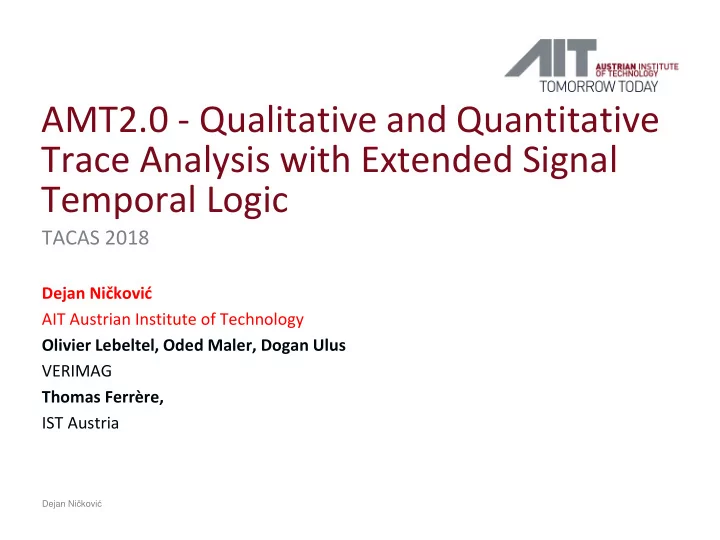

AMT2.0 - Qualitative and Quantitative Trace Analysis with Extended Signal Temporal Logic TACAS 2018 Dejan Ničković AIT Austrian Institute of Technology Olivier Lebeltel, Oded Maler, Dogan Ulus VERIMAG Thomas Ferrère , IST Austria Dejan Ni č kovi ć
Introduction Mixed-signal increasingly important in safety-critical applications Automotive, avionics, medical… Sensors ↔ Controllers ↔ Actuators V&V is a challenge Simulation-based testing a common approach Property-based analysis of simulation traces
Property-based Monitoring Technology Rigourous Not ambiguous Automatic Scalable Reusable AMT2.0 23.04.2018 3
AMT2.0 Highlights Extended Signal Temporal Logic Signal Temporal Logic Timed Regular Expressions Measurement specifications Offline qualitative monitors Trace diagnostics Fault explanations Property-driven measurements Tool functionality via two examples Bounded stabilization property Clock jitter property
Bounded Stabilization Property 23.04.2018 5
Informal Requirement This requirement species conditions that need to hold for a bounded stabilization requirement. At every rising edge of the boolean trigger, the analog signal var is allowed to oscillate under the following conditions: var must always remain below 5V ; and var must within 600s go below 0.2V , and continuously remain under that threshold for at least 300s.
Simulation Traces No stabilization Stabilization Signal too high Stabilization too slow Glitches
Formalization of the Requirement in xSTL bool trigger ; real var0; … Variable and constant real var5; declarations const real vh = 5; const real vl = 0.2; template bool stabilization ( bool tg , real x, real vhigh , real vlow ) { bool result = ((x <= vhigh) and (rise(tg) -> Property templates (eventually[0:600] always[0:300] x <= vlow))); return result ; } assertion one: always ( stabilization ( trigger , var0 , vh , vl)); … assertion five : always ( stabilization ( trigger , var5 , vh , vl)); 23.04.2018 8
Property Evaluation – Offline Marking 5 x x ≥ 5 eventually [1,3] (x ≥ 5) always eventually [1,3] (x ≥ 5) 0 2 4 6 8
Property Evaluation 23.04.2018 10
Trace Diagnostics We focus on signals trigger and var4 Assertion violated because top formula violated at time 100s 23.04.2018 11
Trace Diagnostics Top formula violated at time 100s because trigger is at its rising edge at time 100s, but the future obligation eventually[0:600]always[0:300] (var4 <= 0.2) is not met because there is not time in [100s,700s] from which var4 stays continuously below 0.2 for at least 300s 23.04.2018 12
Trace Diagnostics there is not time in [100s,700s] from which var4 stays continuously below 0.2 for at least 300s because var4 goes above 0.2 at regular intervals smaller than 300s because of glitched – for instance at times 350s, 600s and 750s 23.04.2018 13
Clock Jitter Property 23.04.2018 14
Informal Requirement and Input Signal This requirement species a digital clock jitter pattern to measure. Given a continuous- time Boolean-valued signal clock, a clock period is defined as a segment that starts with the rising edge of the clock and ends with its consecutive rising edge. The measurement specification requires measuring the duration of all the clock periods matched within the clock signal.
Formalization of the Requirement in xSTL bool clock; bool nclock = not clock; measurement jitter_clock_period { pattern clock_period = start(clock):clock:nclock:start(clock); measure duration(clock_period); } Mesurement specification With TRE 23.04.2018 16
Property Evaluation 23.04.2018 17
Summary and Additional Insights 23.04.2018 18
AMT2.0 Algorithms Offline monitoring algorithm with full STL semantics (including events) Oded Maler, Dejan Nickovic: Monitoring properties of analog and mixed-signal circuits. STTT 15(3): 247-268 (2013) Timed regular expressions matching Dogan Ulus, Thomas Ferrère, Eugene Asarin, Oded Maler: Timed Pattern Matching. FORMATS 2014: 222-236 Timed regular expressions measurements Thomas Ferrère, Oded Maler, Dejan Nickovic, Dogan Ulus: Measuring with Timed Patterns. CAV (2) 2015: 322-337 Trace diagnostics for STL Thomas Ferrère, Oded Maler, Dejan Nickovic: Trace Diagnostics Using Temporal Implicants. ATVA 2015: 241-258 23.04.2018 19
xSTL – Combining STL and TRE STL formula within TRE pattern Implicit Example: (not clock and reg):clock TRE pattern within STL formula Explicit projection operators match_begin and match_end Example: match_end(not clock:clock) -> eventually reg 23.04.2018 20
AMT2.0 Features - Summary New specification language STL + TRE Easier specifications • Declaration of typed variables and constants • Reusable property templates Measurement specifications Trace diagnostics with temporal implicants Small and hierarchical explanations of violations Continuous signal interpolation and interpretation Linear and step interpolation Reals as floats or rationals Tool portability Java implementation Delay with the release 23.04.2018 21
Thank you! 23.04.2018 22
Recommend
More recommend